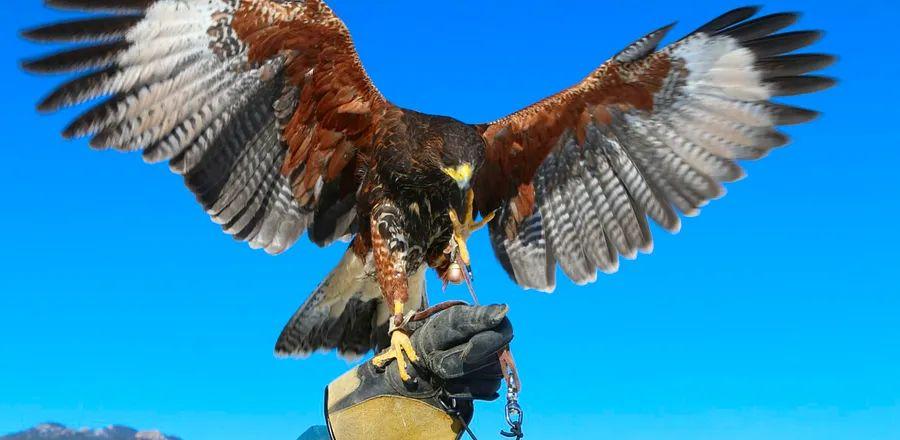Some Luxury Hotels Are Now Home to Uncommon Staff—Falcons, Hawks, and Eagles

With a thick suede falconer’s glove, Deanna Curtis gently transfers Cupid, a barn owl the hue of a perfectly toasted marshmallow, from his enclosure to a wooden perch. Although he seems more captivated by the bag of game meat at Curtis’s side, he doesn’t appear to notice my presence.
That is, until I raise my own sheathed fist. Instantly, Cupid’s amber eyes lock onto me—he senses a treat is nearby. With a shriek, he spreads his nearly three-foot wingspan, swiftly crosses the 20 feet that separate us, and lands on my wrist. He grabs the morsel and tears it into smaller bits with his talon and beak. To my surprise, he’s quite light—around a pound.
We find ourselves in the mews (an indoor stable for trained raptors) at the Broadmoor, a luxurious five-star resort with a 131-year history, nestled at the foot of Pikes Peak in Colorado Springs, Colorado. Here, a select group of licensed falconers, including Curtis, offer guests the chance to engage in the Sport of Kings.
Falconry—hunting alongside birds of prey—dates back approximately 4,000 to 9,000 years in the Middle East. While still practiced there, it reached its zenith in Europe during the Middle Ages, when aristocrats regarded noble falcons and hawks as symbols of status (hence the sport's regal nickname). Although interest waned in the West after firearms simplified hunting, luxury hotels have recently rekindled enthusiasm for this ancient tradition by offering falconry classes to their guests.
Apart from the Broadmoor, several U.S. hotels offer falconry experiences, including Troutbeck in New York, Rancho Bernardo Inn in California, and the Omni Homestead Resort in Virginia, among others.
"The purpose of these classes is to provide individuals with an intimate experience of the sport, showcasing various raptor species while educating them about the historical and current conservation efforts in falconry," said Katheryn Wickberg, a falconry instructor at the Broadmoor.
Falconry gained traction in the United States only in the early 1900s, initially drawing interest from men’s clubs at eastern universities. (Native Americans traditionally regarded these birds as celestial messengers rather than creatures to be trained for hunting.) Currently, there are approximately 4,000 certified falconers across the United States.
"We’re not a large group of quirky, eccentric individuals," Curtis quipped.
This scarcity is largely because falconry is the most strictly regulated sport in the country, influenced by political factors and animal welfare concerns. To obtain certification, one must first complete a two-year apprenticeship under an experienced falconer. After that, aspiring falconers must pass a rigorous 100-question exam before acquiring their own bird. Achieving master falconer status, like Curtis, requires an additional five years of training.
Although the North American Falconers Association doesn't track the gender of its members, Carol Speegle, the assistant corresponding secretary, remarked, "It's safe to say that there are more men involved. However, the sport is expanding, especially as finding a mentor has become much easier in our digitally connected era."
Wickberg agreed, stating, "In recent years, the demographic landscape of falconry has been evolving across the nation, with a noticeable increase in participation from women and minorities."
This trend is primarily seen in the U.S. While UNESCO recognized falconry as part of the Representative List of Intangible Cultural Heritage of Humanity in 2010, the activity remains largely male-dominated in many parts of the Middle East and Asia.
At the Broadmoor, the staff falconers care for seven birds of prey in addition to Cupid, including two falcons (a peregrine named Earl and a lanner named Lance), four Harris’s hawks (Goldie, Maverick, Goose, and Ice Man), and a Eurasian eagle owl named Layla. They also have a bird in training they plan to introduce soon and are looking to expand their program with more additions in the upcoming months. Curtis personally owns two raptors (a Harris’s hawk named Roscoe and a peregrine falcon named Drake), both acquired as juveniles. Curtis explained that about 75 percent of wild birds do not survive their first year, largely due to starvation. Capturing a bird during this critical time and teaching it to hunt can significantly improve its chances of survival later on.
As we stroll through a golf course that has been transformed into a falconry space on the Broadmoor grounds, with Goose the Harris’s hawk soaring ahead, Curtis emphasizes the nature of their relationship—it’s a partnership. The birds have the freedom to leave whenever they wish, yet they choose to return. However, they aren't pets; the birds stay for the food, not out of emotional bonds.
"Try extending your hand," she instructs. As I comply, Goose notices the motion, veers to the left, and in no time is perched on my fist. He gazes at me with anticipation, but since there’s no treat in my palm this time, he takes off until the next gloved hand appears.
On our way back to the car, Curtis asks if I enjoyed my introduction to the Sport of Kings. I respond affirmatively, mentioning that I'm already eager to give it another go.
"Great," she replied. "Perhaps if more women join in, falconry will earn a fresh nickname."

1

2

3

4

5
Evaluation :
5/5